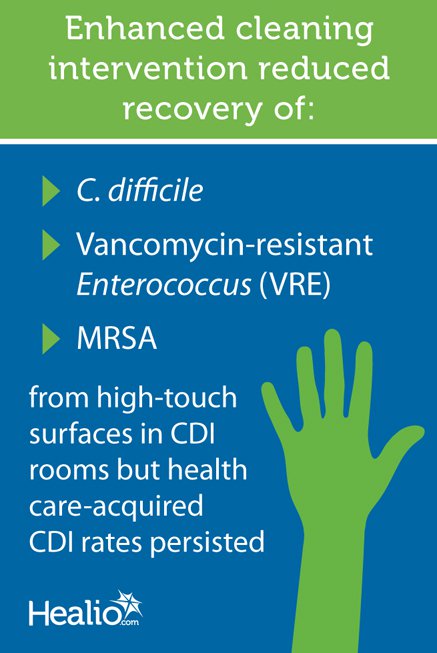Hospital-acquired CDI Rates Persist Despite Enhanced Cleaning
Although a cleaning intervention decreased the recovery of certain bacteria on high-touch surface areas in hospital settings, it did not reduce the incidence of health care-acquired Clostridium difficile infections, according to findings presented at The Society for Healthcare Epidemiology of America spring conference.
The findings are in contrast to results of multiple quasi-experimental studies that showed interventions designed to eradicate C. difficile spores from the environment were associated with reductions in health care-associated C. difficile infections (CDIs), according to Curtis J. Donskey, MD, professor of medicine at Case Western Reserve University School of Medicine, and hospital epidemiologist at the Louis Stokes Veterans Affairs Medical Center in Cleveland, Ohio, and colleagues. However, the researchers noted that these studies have a number of limitations, underscoring the need for randomized controlled trials.

Donskey and colleagues conducted a 12-month randomized trial to assess the impact of an enhanced cleaning intervention in seven acute-care hospitals vs. standard cleaning in eight control hospitals. The intervention involved monitoring environmental services (EVS) personnel performance with feedback to EVS and infection control staff.
The researchers reported that the intervention significantly increased thoroughness of cleaning based on fluorescent marker removal in CDI and non-CDI rooms. The intervention also improved the effectiveness of disinfection based on reduced recovery of C. difficile and vancomycin-resistant Enterococcus (VRE) and/or MRSA from high-touch surfaces in the CDI rooms. However, there was no impact on the incidence of health care-acquired CDI.
Donskey and colleagues noted that their results are consistent with another recent randomized trial, in which adjunctive use of ultraviolet-C room disinfection devices was not associated with a reduction in CDI in comparison to the use of bleach alone.
“The findings of these two large randomized trials suggest that interventions that focus only on improving cleaning may not be sufficient to control health care-associated CDI,” Donskey told Healio Gastroenterology. “Health care facilities faced with high CDI rates should consider other approaches, including antimicrobial stewardship.” – by Stephanie Viguers
References:
Anderson DJ, et al. Lancet. 2017;doi:10.1016/S0140-6736(16)31588-4.
Donskey CJ, et al. A Multicenter Randomized Trial to Determine the Effect of an Environmental Disinfection Intervention. Presented at: Society for Healthcare Epidemiology of America (SHEA) spring conference; March 29-31; St. Louis.
Disclosure: Donskey reports receiving research funding from Altapure, Clorox, EcoLab and GOJO, and serves on an advisory board for 3M.
